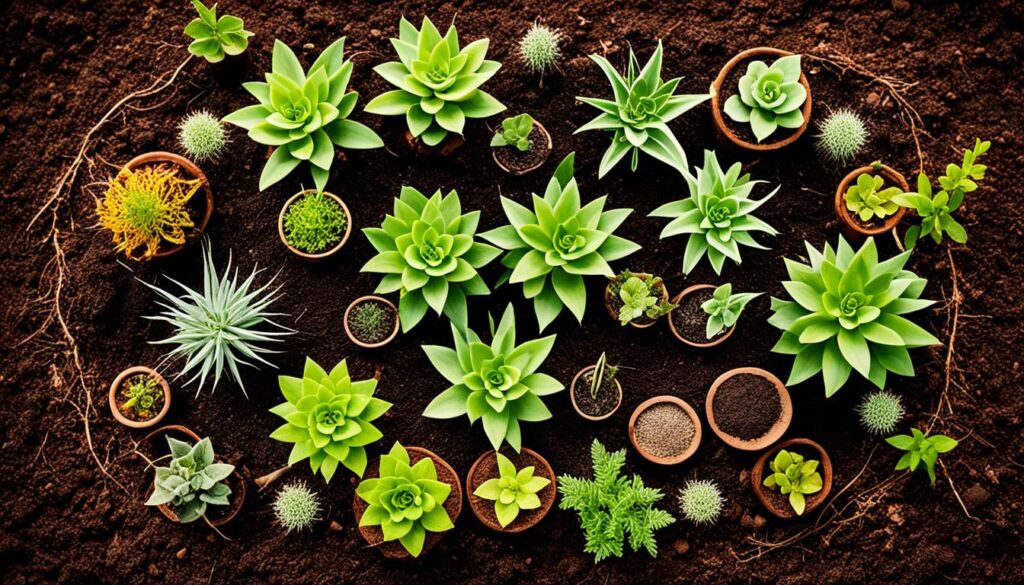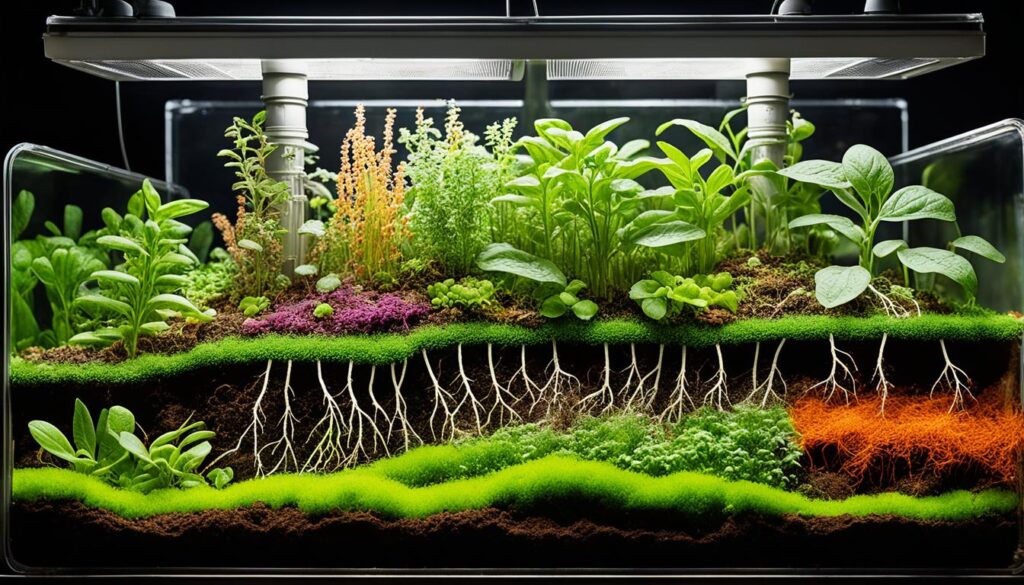Improving Soil Health with Companion Planting
Are you tired of dealing with poor soil in your garden? Wondering if there’s a natural way to make your soil better? Look into companion planting. By pairing certain plants together, you can make your soil richer and healthier. This creates a thriving garden ecosystem.
This article will show you how companion planting can improve soil health. It helps with fertility, keeps nutrients balanced, and supports good microbes. It also cuts down on the need for harmful chemicals. Get ready to see how this gardening trick can change your garden!
Key Takeaways
- Companion planting can significantly enhance soil fertility and nutrient balance.
- Strategic plant pairings can create a more diverse and resilient soil ecosystem.
- Certain companion plants can help suppress pests and diseases, reducing the need for chemical interventions.
- Integrating cover crops and green manures into your companion planting system can further improve soil health.
- Companion planting can also help your plants become more drought-resistant and better able to withstand challenging environmental conditions.
The Benefits of Companion Planting
Companion planting is great for making soil healthier and more fertile. By pairing soil-enriching plants and nutrient-boosting plants, you make a garden that helps each plant grow better. This method makes your garden more vibrant and healthy.
Enhancing Soil Fertility
Having different roots in your garden is key to better soil. Plants like broccoli and cabbage grow close to the surface. They work well with tomatoes, which have deeper roots. This way, they get different nutrients from the soil.
Adding plants like peas, beans, and clover can also help. These plants fix nitrogen in the soil. When they break down, they give back nitrogen to the soil. This cuts down on the need for chemical fertilizers.
Maintaining Nutrient Balance
Companion planting keeps the soil balanced and healthy. By growing many different plants, you make your garden strong against nutrient shortages. This keeps the soil rich and supports many types of crops.
“Companion planting is a powerful tool for gardeners and farmers alike, as it allows them to harness the natural synergies between plants to improve soil health and fertility.”
Companion planting is a big win for soil health. By choosing the right soil-enriching plants and nutrient-boosting plants, you create a garden that feeds itself. This leads to a garden full of diverse and healthy plants.
Understanding Companion Planting Arrangements
Successful companion planting means knowing how different plants work together and with their environment. Things like plant height, growth patterns, and how they fight pests or diseases are key. By picking and placing your plants right, you can make a garden that’s healthier and more productive.
When looking at companion planting arrangements, keep these main points in mind:
- Compatibility: Choose plants that grow well together, need similar nutrients, and resist pests and diseases.
- Companion planting techniques like intercropping, succession planting, and polycultures help use space better and increase diversity.
- Plan your companion planting patterns to make the most of light, water, and nutrients for all plants.
| Companion Plant | Beneficial Attributes | Ideal Companions |
|---|---|---|
| Marigolds | Repels nematodes, attracts beneficial insects | Tomatoes, peppers, eggplants |
| Nasturtiums | Trap crops for aphids, adds nutrients to soil | Cucumbers, radishes, cabbage |
| Chamomile | Improves soil health, deters pests | Onions, carrots, brassicas |
Learning about companion planting arrangements helps you make a garden that fights pests, diseases, and stress better.
“Companion planting is not just about which plants grow well together, but how they can support each other’s growth and health.”
Intercropping: Maximizing Space and Diversity
Intercropping means growing different crops together in one spot. It’s great for gardeners and small farmers. By mixing early and late crops, you can maximize your garden space and boost diversity. This method makes your garden look better and helps your plants grow healthier and more productive.
Planting Patterns and Techniques
Choosing the right companion planting patterns and techniques is key. For instance, grow quick-growing crops like lettuce or spinach with slower ones like peppers or tomatoes. This way, you use your space well.
Intercropping lets you use the unique growth and needs of different plants. It makes your garden stronger and more productive. You get better pest and disease control, richer soil, and a balanced nutrient cycle.
“Intercropping is a sustainable and efficient way to grow a diversity of crops in a limited space, while also supporting the overall health of your garden ecosystem.”
To make the most of intercropping, try out different patterns and techniques. Watch how your plants do together and adjust as needed. With creativity and care, you can enjoy the benefits of intercropping and turn your garden into a lush, diverse place.
Amending Soils with Companion Planting
Improving soil health is easy with companion planting. By picking the right plants together, you can fix nutrient gaps and make your soil richer. This method uses amending soil with companion plants to boost your garden’s health.
Adding nutrient-boosting plants to your garden helps refill the soil with what it needs. Legumes like peas or beans add nitrogen. Plants with deep roots, such as comfrey or dandelions, bring up minerals from deep down.
- Increase mulch around plant bases to retain moisture and improve soil structure
- Add earthworms to aerate compacted soils and enhance nutrient cycling
- Integrate cover crops to help replenish depleted soil nutrients and improve overall soil health
By choosing the right soil amendment techniques, your garden can become a place of growth and health. Watch your soil and pick the best companion plants to fill any gaps. This way, your garden will be full of life and productivity.
“Companion planting is a powerful tool for improving soil health and creating a more sustainable, self-regulating garden ecosystem.”

improving soil health with companion planting
Using companion planting can make your soil healthier and more lively. It creates a diverse garden that boosts soil fertility and keeps nutrients balanced. This helps plants grow better, fight off pests, and makes your garden more sustainable.
Companion planting for soil health lets you add soil-enriching plants to your garden. These plants fix nitrogen, gather minerals, or release compounds that help other plants and soil life.
- Nitrogen-fixing plants, like beans, add more nitrogen to the soil. This cuts down on the need for synthetic fertilizers.
- Plants that improve soil by gathering minerals keep the soil balanced. This makes sure plants get what they need to grow well.
- Root exudates and healthy microbes from plants make the soil better for plant growth.
Choosing and arranging your companion planting wisely helps plants work together. This approach makes your garden healthier and more productive. It also makes the soil better and creates a strong, diverse garden ecosystem.
“Companion planting is a powerful tool for building healthy, living soil that supports vibrant, resilient plant life.”
Adding companion planting for soil health is good for the planet and your garden. It uses plant synergies to create a system that needs less outside help. This keeps your soil fertile and productive for a long time.
The Role of Root Exudates and Soil Microbes
Companion planting changes the soil microbiome in big ways, thanks to root exudates. These are compounds released by plant roots that help beneficial soil microbes grow. By knowing how root exudates and soil microbes work together, gardeners and farmers can create a healthy soil community. This supports soil health and keeps the ecosystem balanced.
Promoting Beneficial Microbial Communities
Some plants release compounds through their roots that help beneficial microorganisms grow. These microbes are key in nutrient cycling, fighting off diseases, and making soil fertile. By choosing the right plant partners, gardeners can build a strong soil microbiome. This helps crops stay healthy and productive.
- Certain root exudates boost nitrogen-fixing bacteria, making more nutrients available.
- Other exudates stop soil-borne pathogens, lowering the chance of plant diseases.
- A diverse community of beneficial soil microbes improves soil structure, water retention, and nutrient cycling.
Using companion planting, gardeners and farmers can create a lively soil microbiome. This supports the health and strength of their plants.

“The soil microbiome is the foundation of a healthy, productive ecosystem. By understanding the role of root exudates, we can unlock the true potential of companion planting to foster a diverse and beneficial microbial community.”
Pest and Disease Management through Companions
Companion planting is a great way to control pests and diseases naturally in your garden. By placing different plants together, you make your garden less welcoming to pests. This means you use fewer chemicals and your garden stays healthier.
Some plants smell bad to pests, keeping them away from your crops. Others hide the look of your plants from pests. And, some plants bring in good bugs like ladybugs that eat the bad bugs.
- Companion planting for pest control can help reduce the reliance on synthetic pesticides.
- Companion plants can emit odors or visually camouflage target crops, making them less appealing to pests.
- Certain companion species can attract beneficial insects that prey on common garden pests.
By mixing different plants together, you make a garden that fights pests and diseases on its own. This method cuts down on harmful chemicals. It also helps your plants and local wildlife thrive together.
| Companion Plant | Pest or Disease Targeted | Mechanism of Action |
|---|---|---|
| Marigolds | Nematodes, aphids, and other garden pests | Marigolds release a compound called thiopene, which acts as a natural pest repellent. |
| Nasturtiums | Aphids, whiteflies, and other sucking insects | Nasturtiums produce a strong scent that can confuse and deter many garden pests. |
| Basil | Tomato hornworms and mosquitoes | Basil’s fragrant leaves can repel tomato hornworms, and the plant’s essential oils also act as a natural mosquito deterrent. |
Using these companion plants for disease resistance helps your garden fight pests naturally. This method is better for your plants and the environment. It makes your garden healthier and more sustainable.
Nutrient Cycling and Soil Enzyme Activities
Companion planting greatly affects nutrient cycling and soil enzyme activities. These are key to soil health. The roots and chemicals from different plants help soil enzymes break down organic matter and release nutrients.
The Impact of Companion Plants
This boosts soil fertility and plant growth. By knowing how nutrient cycling in companion planting, soil enzyme activities, and how companion plants impact soil work together, gardeners can improve their crops. This leads to better productivity and sustainability.
| Nutrient Cycling Indicator | Impact of Companion Plants |
|---|---|
| Soil Enzyme Activity | Increased activity of enzymes involved in organic matter decomposition and nutrient mobilization |
| Nitrogen Cycling | Improved nitrogen fixation and availability through legume companions |
| Phosphorus Cycling | Enhanced solubilization and uptake of inorganic phosphorus |
| Potassium Cycling | Improved mobilization and recycling of potassium from mineral sources |
By using nutrient cycling in companion planting, gardeners and farmers can make their soil better. This leads to healthier plants and more food.
Companion Planting for Drought Resistance
Gardening in dry areas requires plants that can handle drought well. Companion planting is a great way to make gardens more resilient. Some plants have deep roots that help keep soil moist for others.
Companion planting also improves soil health. As different plants grow together, their roots mix and break down, making soil better at holding water. This means your garden can survive with less water.
| Drought-Resistant Companion Plants | Characteristics |
|---|---|
| Lavender (Lavandula spp.) | Deep, drought-tolerant roots that can help improve soil moisture retention |
| Rosemary (Rosmarinus officinalis) | Aromatic herb with a robust root system, thriving in dry conditions |
| Yarrow (Achillea millefolium) | Extensive root system that can help distribute water to neighboring plants |
Adding these drought-resistant plants to your garden makes your plants stronger and helps your soil hold moisture better. A well-planned garden can handle changing weather and water issues well.
Integrating Cover Crops and Green Manures
Improving soil health and nutrient cycling is key for sustainable farming. Using cover crops and green manures can change the game. Cover crops like legumes, grasses, and brassicas help fix nitrogen, fight weeds, and add organic matter to the soil. Green manures, from decomposed plants or compost, boost nutrients and help beneficial soil microbes.
Choosing the right cover crops for your climate and soil is crucial. Legumes, such as clover and alfalfa, take nitrogen from the air for your crops. Grasses, like rye and oats, build soil matter and stop erosion. Brassicas, including mustard and radish, break up hard soil and release nutrients as they decay.
- Try different cover crop mixes to see what works best for you.
- Plan when to plant and add cover crops with your main crops’ needs.
- Use cover crops and green manures together for a nutrient cycle boost.
Adding cover crops and green manures to your planting can unlock your soil’s full potential. It creates a thriving ecosystem that helps your plants grow. This simple method improves soil health and keeps your land productive for years.
| Cover Crop | Benefit |
|---|---|
| Legumes (e.g., clover, alfalfa) | Nitrogen fixation, improve soil fertility |
| Grasses (e.g., rye, oats) | Increase organic matter, prevent soil erosion |
| Brassicas (e.g., mustard, radish) | Break up compacted soil, release nutrients |
“Integrating cover crops and green manures into your companion planting system is a powerful way to enhance soil health and nutrient cycling, ensuring the long-term productivity of your land.”
Conclusion
Companion planting is a great way to make your garden better. By choosing the right plants together, you can make the soil richer and keep it balanced. This method also helps create a garden that is strong and diverse.
It helps with nutrient cycling and fights pests and diseases naturally. This makes it a green and complete way for gardeners to improve their soil and grow a healthy garden.
Adding companion planting to your garden can make it more productive and good for the planet. It makes the soil better, which means your plants will be healthier and taste better. It also helps the good bugs and cuts down on harm to the environment.
If you’re new to gardening or have been doing it for years, trying companion planting can be exciting. It opens up new ways to garden sustainably and makes your garden more lively and full of life.
Using companion planting lets you make the most of your garden. It creates a balanced and self-supporting garden that’s good for you and the earth. Start using companion planting to make your gardening better and greener.
FAQ
What are the benefits of companion planting for soil health?
How does companion planting help with nutrient cycling and soil enzyme activities?
Can companion planting help manage pests and diseases naturally?
How can companion planting improve a garden’s resilience to drought conditions?
How can cover crops and green manures be integrated into a companion planting system?
Source Links
- 10 Must-Have Blooms for Your 2025 Garden
- The Health Advantages of Gardening You Need to Know
- How to Create a Small Vegetable Garden Layout Plan: A Beginner’s Guide
- DIY Garden Projects for Small Spaces: Upcycling Ideas to Maximize Your Garden
- Watering Techniques for Small Gardens: Ensuring Your Plants Thrive
- Small Border Plants for Landscaping: Adding Beauty and Functionality to Your Garden
- Year-Round Small Space Gardening: Seasonal Planting Tips for Maximum Harvest
- Essential Tools for Small-Space Gardening: What You Really Need
- The Ultimate Guide to Container Vegetables: What to Grow in Small Spaces
- Budget-Friendly Gardening: How to Create a Thriving Garden on a Tight Budget
- How to Optimize Sunlight in Small Gardens: Tips for Better Plant Growth
- DIY Vertical Planters: Creative Ideas for Small Space Gardening
- Companion Planting for Small Vegetable Gardens: Boost Growth and Deter Pests
- Container Gardening Essentials: Choosing the Right Pots, Soil, and Plants
- Vertical Gardening Techniques: Maximizing Your Small Space with Climbers and Vines
- How to Build a Raised Bed Garden in a Small Backyard: Step-by-Step Guide
- The Best Vegetables for Small-Space Gardens: High-Yield Varieties You Need to Grow
- Smart Vegetable Garden Layouts for Small Spaces: Maximizing Your Green Thumb in Compact Areas
- 40. Best Practices for Managing a Sustainable Garden Year-Round
- Building a Wildlife Pond for Biodiversity
- Advanced Techniques in Sustainable Gardening
- How to Create a No-Till Garden
- The Mental Health Benefits of Gardening
- Using Technology to Enhance Sustainable Gardening
- Getting Certified Organic: Steps and Benefits

Leave a Reply